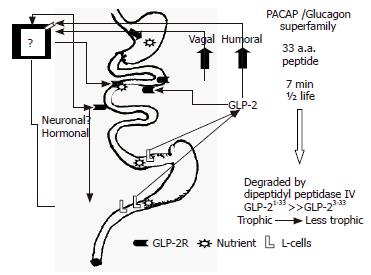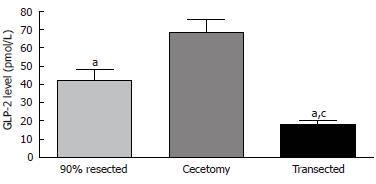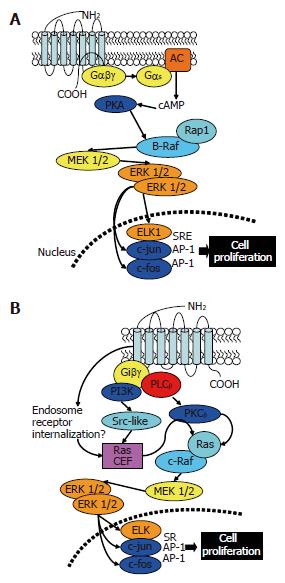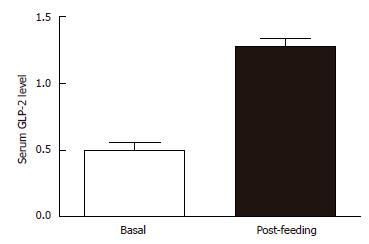Copyright
©2006 Baishideng Publishing Group Co.
World J Gastroenterol. Jul 14, 2006; 12(26): 4117-4129
Published online Jul 14, 2006. doi: 10.3748/wjg.v12.i26.4117
Published online Jul 14, 2006. doi: 10.3748/wjg.v12.i26.4117
Figure 1 Potential pathways involved in the production, release, activity, and sites of action of GLP-2.
GLP-2 produced by the L-cell is induced following the ingestion of a meal and can be induced either by direct stimulation of the L-cell, or potentially following the release of upstream neuronal /hormonal agonists. The GLP-2R has been localized to components of the enteric nervous system (ENS) and to regions of the brain, thus the growth-promoting effects associated with GLP-2 may involve interactions with the brain-gut axis. Potentially the ENS / vagal interface might be responsible for the early release of GLP-2.
Figure 2 An experimental rat model of SBS-induces changes in circulatory GLP-2 levels.
The distal regions of the small bowel and/or the large intestine are necessary for GLP-2 production. In these experiments, the entire proximal small bowel was removed; therefore the distal ileum and/or the colon are likely the cells responsible for the production of GLP-2 as all other bowel tissue had been removed. Resected = 90% intestinal resection leaving a 10 cm ileal remnant. CEC = cecetomy + removal of all but 20 cm of jejunum. The remnant jejunum was anastomosed to the ascending colon. aP < 0.05 vs cecetomized animals; cP < 0.05 vs 90% proximal resected animals that were enterally-fed (10 cm remnant ileum).
Figure 3 A: GLP-2 stimulation of the Gs-Coupled Receptor induced cell proliferation.
The proposed GLP-2 /GLP-2R signaling pathway as characterized in cells that were transfected with the GLP-2R. See section on GLP-2 receptor-activity for description (pages 11-12); B: GLP-2 stimulation of the Gαi-Coupled Receptor induced cell proliferation. Possible trafficking pathways triggered by GLP-2 in cells that tested negative for the characterized GLP-2R. Potentially, GLP-2 induces divergent signaling pathways which results in an increase in the rate of cell proliferation. See section on GLP-2 receptor-activity for description (pages 11-12).
Figure 4 GLP-2 stimulation of the enteric nervous system.
GLP-2 binds to 7-TM G protein-coupled receptors localized to components of the ENS. This results in a conformational change in the GLP-2R that eventually activates c-fos expression via the Gαs, AC, c-AMP pathway. This suggests that a rise in circulatory GLP-2 levelsmight stimulate the GLP-2R leading to an increased stimulation of the myenteric and/or submucosal neurons. Potentially the trophic effects on the gut mucosa associated with GLP-2 are the result of a second downstream mediator, either a neurotransmitter or direct innervation that is activated upon GLP-2’s initial stimulation of the ENS localized GLP-2R.
Figure 5 Neural or humoral mechanism involvement in the early release of GLP-2.
The delivery of a meal significantly increases serum GLP-2 levels in rats with discontinuous small bowel (ANOVA, P < 0.007). The disruption of the continuity of the bowel (stoma creation) did not inhibit the initial nutrient-stimulated GLP-2 response. Thus, GLP-2 production is increased at least in part by neural and/or hormonal mechanisms. Serum GLP-2 levels reported as ng/mL.
- Citation: Martin G, Beck P, Sigalet D. Gut hormones, and short bowel syndrome: The enigmatic role of glucagon-like peptide-2 in the regulation of intestinal adaptation. World J Gastroenterol 2006; 12(26): 4117-4129
- URL: https://www.wjgnet.com/1007-9327/full/v12/i26/4117.htm
- DOI: https://dx.doi.org/10.3748/wjg.v12.i26.4117













